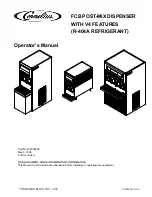
5
Packing List
Inspect Shipment
Water Conditioning Information
IRON
Iron in water can cause stains on clothing and plumb-
ing fixtures. It can negatively affect the taste of food,
drinking water, and other beverages. Iron in water is
measured in parts per million (ppm). The total* ppm of
iron, and type or types*, is determined by chemical
analysis. Four different types of iron in water are:
=
Ferrous (clear water) iron
=
Ferric (red water) iron
=
Bacterial and organically bound iron
=
Colloidal and inorganically bound iron (ferrous or
ferric)
Ferrous (clear water) iron is soluble and dissolves in
water. This water softener will reduce moderate
amounts of this type of iron (see specifications).**
Ferrous (clear water) iron is usually detected by taking
a sample of water in a clear bottle or glass.
Immediately after taking, the sample is clear. As the
water sample stands, it gradually clouds and turns
slightly yellow or brown as air oxidizes the iron. This
usually occurs in 15 to 30 minutes.
When using the softener to reduce Ferrous (clear
water) iron, add 5 grains to the hardness setting for
every 1 ppm of Ferrous (clear water) iron. See "Set
Water Hardness Number" section.
Ferric (red water), and bacterial and organically bound
irons are insoluble. This water softener will not
remove ferric or bacterial iron. This iron is visible
immediately when drawn from a faucet because it has
oxidized before reaching the home. It appears as
small cloudy yellow, orange, or reddish suspended
particles. After the water stands for a period of time,
the particles settle to the bottom of the container.
Generally these irons are removed from water by filtra-
tion. Chlorination is also recommended for bacterial
iron.
Colloidal and inorganically bound iron is of ferric or fer-
rous form that will not filter or exchange out of water.
This water softener will not remove colloidal iron. In
some instances, treatment may improve colloidal iron
water. Colloidal iron water usually has a yellow
appearance when drawn. After standing for several
hours, the color persists and the iron does not settle,
but remains suspended in the water.
SEDIMENT
Sediment is fine, foreign material particles suspended
in water. This water softener will not remove sedi-
ment. This material is most often clay or silt. Extreme
amounts of sediment may give the water a cloudy
appearance. A sediment filter installed upstream of
the water softener normally corrects this situation.
* Water may contain one or more of the four types of
iron and any combination of these. Total iron is the
sum of the contents.
** Capacity to reduce clear water iron is substantiated
by laboratory test data.
The parts required to assemble and install the water
softener are included with the unit. Thoroughly check
the water softener for possible shipping damage and
parts loss. Also inspect and note any damage to the
shipping carton.
Remove and discard (or recycle) all packing materials.
To avoid loss of small parts, we suggest you keep the
small parts in the parts bag until you are ready to use
them.
FIG. 2
Bypass Valve
Drain Hose
Adaptor Elbow
Clips
(including 1 spare)
Hose Clamps
Grommet
Cover Lock
(for shipping only)
Rim Insert
(for shipping only)
Summary of Contents for EP31
Page 23: ...23 Notes...






































